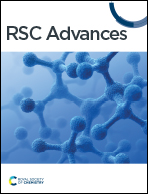Complete characterization of RNA biomarker fingerprints using a multi-modal ATR-FTIR and SERS approach for label-free early breast cancer diagnosis†
Abstract
Breast cancer is a prevalent form of cancer worldwide, and the current standard screening method, mammography, often requires invasive biopsy procedures for further assessment. Recent research has explored microRNAs (miRNAs) in circulating blood as potential biomarkers for early breast cancer diagnosis. In this study, we employed a multi-modal spectroscopy approach, combining attenuated total reflection Fourier transform infrared (ATR-FTIR) and surface-enhanced Raman scattering (SERS) to comprehensively characterize the full-spectrum fingerprints of RNA biomarkers in the blood serum of breast cancer patients. The sensitivity of conventional FTIR and Raman spectroscopy was enhanced by ATR-FTIR and SERS through the utilization of a diamond ATR crystal and silver-coated silicon nanopillars, respectively. Moreover, a wider measurement wavelength range was achieved with the multi-modal approach than with a single spectroscopic method alone. We have shown the results on 91 clinical samples, which comprised 44 malignant and 47 benign cases. Principal component analysis (PCA) was performed on the ATR-FTIR, SERS, and multi-modal data. From the peak analysis, we gained insights into biomolecular absorption and scattering-related features, which aid in the differentiation of malignant and benign samples. Applying 32 machine learning algorithms to the PCA results, we identified key molecular fingerprints and demonstrated that the multi-modal approach outperforms individual techniques, achieving higher average validation accuracy (95.1%), blind test accuracy (91.6%), specificity (94.7%), sensitivity (95.5%), and F-score (94.8%). The support vector machine (SVM) model showed the best area under the curve (AUC) characterization value of 0.9979, indicating excellent performance. These findings highlight the potential of the multi-modal spectroscopy approach as an accurate, reliable, and rapid method for distinguishing between malignant and benign breast tumors in women. Such a label-free approach holds promise for improving early breast cancer diagnosis and patient outcomes.



 Please wait while we load your content...
Please wait while we load your content...